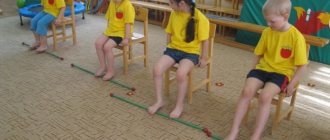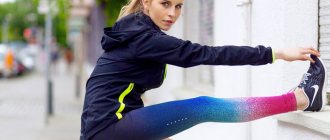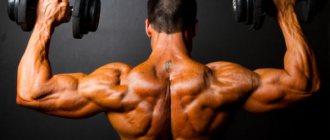What makes a strong brush
The strength of our grip is formed due to the total activity of the muscles of the hand and forearm. If you squeeze something in your hand, you will see which muscles tense at this time.
Take a glass in your hand and try to squeeze it slightly - note that not only the hand is tense, but also the muscles from the wrist to the elbow - forearm.
This means that in order to develop our hands, to strengthen them, we need to purposefully do exercises for all these muscles. Just squeezing a ring expander won't do it.
And the more comprehensive the approach to solving this issue, the better result you will get.
Let's imagine that you have a grip competition coming up. Let's train!
Types of Grip Strength
To understand how to train your hand muscles and grip strength, let’s first figure out what grip strengths there are:
- Compressive. You can appreciate it with a handshake. Trains the compression grip mainly with the help of expanders.
- Holding. With this strength, you can hold objects for a long time. In sports, holding force is used, for example, during the stiff-legged deadlift exercise.
- Plucked. It is also called thumb strength. It allows you to hold an object between your thumb and index finger.
- Wrist strength. Take the chair by the leg and try to hold it with your straight arm. In this case you will feel your wrist strength. The strength of the entire forearm directly depends on it.
Exercises for developing hands
Don’t worry about how to pump up your hands at home – it’s quite convenient to do this at home. Exercises for arms and hands do not require special equipment. If you go to the gym, that’s great, but you can do without it in this situation.
Clenching and unclenching the palm
So, let's find out how to pump up your hands.
The very first and simplest exercise, which is performed, including as rehabilitation after serious injuries associated with rupture of muscles and nerves, is the usual clenching of the hand into a fist.
It is done like this:
- In any position (standing, sitting, lying down), clench your fists as tightly as possible. Hold the tension for 5-7 seconds.
- Open your palm, trying to straighten your fingers as much as possible.
Believe it or not, this exercise is difficult for some. After complex operations, a person learns to move his fingers again. It is with such exercises that rehabilitation begins.
If your hands are completely healthy and you have not received any injuries, work with a wrist expander. At the first stage, you can use a rubber ring, and then switch to a spring metal one.
As soon as you manage to perform 50 compressions of the selected wrist expander, move on to a harder one. The load must constantly increase.
Various types of expanders allow you to perform acupressure exercises for the hands.
Choose an expander to your liking - there are round-ring, V-shaped, with a shifted center of gravity, various balls, and with a dynamometer. The last option is interesting because you can monitor the growth of your grip strength.
This is the simplest option that allows you to pump your arms at home.
Horizontal bar
Have you ever thought that your grip swings on the horizontal bar? Why then does it become easier to hang on it every time? Do you remember when you first came to the horizontal bar, how long were you able to hang there, was it difficult to do? Yes. Now you just grab the bar and hang.
To pump up your wrists, you need to systematically hang on the horizontal bar for 60–90 seconds. This is also beneficial for the spine - it stretches, thereby reducing the compressive effect on the roots of the spinal cord. Try hanging like this every other day or every day.
By the way, if you hang a towel on the horizontal bar, grab it with both hands and train hanging in this position, you can pump up your hand even better. This technique is used by wrestlers because grip is very important to them.
Deadlifts and other exercises
Those who go to the gym and exercise without athletic gloves develop calluses on their hands. It’s not for nothing that all this happens – the hands receive a powerful load. The arms get the most peak load from exercises such as shrugs and deadlifts. Especially the last exercise, when done with decent weights, significantly strengthens your grip.
To strengthen your grip as effectively as possible, do not grab the bar with different grips when your arms are turned in different directions. This significantly reduces the stress on the fingers and palm.
Those who successfully do deadlifts are rarely interested in how to strengthen their hands - as a rule, they already receive sufficient load. However, increasing your grip strength helps you achieve better results in such exercises.
Strengthening your fingers
It happens that the grip is generally good, but the fingers are weak and thin. The question arises, how to pump up your fingers. If you pay attention to the anatomy of the fingers, you will see that there are practically no muscles, only tendons. Therefore, your fingers are unlikely to become thicker (and this is not necessary), since the tendons grow very slowly and reluctantly. The main muscles are concentrated in the palm and between the thumb and index finger. Here they grow well, making your palm more impressive.
Tendons become stronger under progressive load, just like muscles. This means you need to do exercises for your fingers.
The simplest thing that comes to mind is finger push-ups. However, don’t immediately stand on the floor on your toes, because we don’t yet know how strong your fingers are. In the worst case, you could break one of your fingers.
To protect yourself, come to the table. Place your fingers on it as if you are going to stand on them. Press down from above with your body until you feel pain. If you need to lean heavily on top before pain appears, then you can try standing on your toes on the floor.
- Get into a push-up position. Place one knee on the floor and place your center of gravity on it.
- Stand on your toes. Gradually remove your knee. The stress on your fingers will increase. If you manage to stand on your toes, try standing there for 5–10 seconds.
- Make sure that your fingers do not bend in the opposite direction!
If you experience any discomfort, do not overcome yourself; stop the exercise.
If you have strong fingers and you stand comfortably on them in a push-up position, try tightening your palm. Your body will rise slightly.
The next level will be doing push-ups on your fingers.
This exercise will also help pump up your hands. If it hurts you to do it, it doesn’t matter, there are many other options!
For example, you can solve the question of how to pump up your fingers using a ring expander. You can grab it with your fingertips and squeeze it if you can manage it. When working with an expander, the entire palm is loaded, including the fingers.
Bending and extending arms with a barbell
Hand training can be done with a barbell. You need to place your hands with the bar on your knees, fixing your elbows and shoulders, that is, everything above the wrist.
Next, do flexion and extension of the arms at the wrists. In fact, in both cases, bending will result. Just one exercise is done with a reverse grip, and the second with a straight grip.
This is a good hand exercise when you feel like your grip isn't strong enough on certain exercises (like deadlifts).
By the way, when working on biceps with a straight grip, a problem often arises: how to strengthen the wrists. This hand exercise will be very useful for just such a case.
How to enlarge your wrists?
People often want to strengthen their hands and enlarge their wrists in these three cases:
- Sports activities that require heavy lifting. For example, if you have weak arms, it is impossible to pump up your biceps and other muscle groups.
- Martial arts fans and boxers always need constant development of their wrists. This is due to the fact that such training helps to perform strong blows.
- Natural weakness of the hands that prevents you from performing various daily tasks or any other heavy work.
During wrist development, you need to pay attention to a little warm-up, because you can very easily hurt your hands, even when using small weights. Frequent problems when performing various exercises are microtraumas of the tendons. They will make themselves felt very strongly in old age. To avoid such microtraumas, you should do a short warm-up. To do this, you need to fold your hands in a “lock”, and after that you need to perform waves using your hands. This exercise allows you to warm up your wrists very well. It must be performed for three minutes. Then you can switch to general exercises. However, you need to start with the easy ones and gradually move on to heavy manipulations. This will make it possible to avoid injuries and protect yourself.
It is important to be patient, because strengthening muscles requires a lot of time from a person. Having completed several effective exercises, the athlete will not be able to have powerful claws the next morning. An important factor in obtaining a positive result is consistency of training. You don’t need to give yourself “days off” simply because you’re lazy.
Many newcomers to the sport wrap elastic bandages around their arms to strengthen their forearm. However, this does not allow you to get the result from the training that you expect. Your wrists will not become stronger if you use these bands to lift different loads. It is better to do exercises with light weights to achieve good results. It is important to know that changes in wrist width are directly related to body structure. Therefore, you should not count on huge wrists if the person himself is thin by nature.
How to combine exercises
There is no point in doing just one exercise. It is useless to pump up your brushes with just a rubber donut. Even the fist muscles require a comprehensive approach.
The list of exercises for training might look like this:
- Hanging on the horizontal bar.
- Wrist curls with a barbell.
- Expander.
You can change any element to the one you like best.
Now you know how to pump up your wrists using simple and understandable exercises. Train, achieve success, share your results!
Forearm Workout at Home: Reducing Wrist Tension
Wrist Curls on a Dumbbell Bench, Palms Up
- 3 sets of 10-15 reps
- Body part: Forearms and wrists Equipment: Dumbbells
Wrist Curl on Dumbbell Bench, Palms Down
- 3 sets of 10-15 reps
- Body part: Forearms and wrists Equipment: Dumbbells
Hammer grip dumbbell curls
- 3 sets of 10-15 reps
- Body part: Biceps Equipment: Dumbbells
Medium grip push-ups
- 3 sets of 15 reps
- Body Part: Chest Equipment: No
Close grip push-ups
- 3 sets of 10 reps
- Body Part: Chest Equipment: No
Add to Calendar * Add to My Workouts * Print Workout
* — The service is in beta testing
How to cure a dislocated hand at home
I wanted to know what treatment is most effective for a dislocated hand and whether it is possible to solve the problem at home?
The skeleton of the hand is made up of a large number of small carpal bones, semi-joints and joints between them. More often, hand dislocation occurs in the wrist joint. It is formed when a person falls on an outstretched arm or with a strong blow to the joint.
Immediately after receiving an injury, it is extremely important to provide first aid, namely:
- immobilize and fix the injured arm using improvised means;
- apply an ice pack, after wrapping it in a towel;
- in case of severe pain, give the victim a painkiller from the group of non-steroidal anti-inflammatory drugs;
- transport the injured person to the emergency room as quickly as possible. When transporting the affected arm, try not to move it and create comfortable conditions for the victim.
To make a correct diagnosis, the traumatologist after examination will prescribe radiography in 2 projections. There are several types of hand dislocation, namely:
- true,
- perilunar,
- perilano-lunar,
- peritrahedral-lunar,
- transscaphoid-perilunar,
- transscaphoid-translunate.
Depending on the type of wrist dislocation, the doctor will determine treatment and subsequent rehabilitation.
As a rule, all hand dislocations require reduction under local anesthesia and the application of a plaster splint from the base of the fingers to the elbow joint, with the hand bent at an angle of 40 degrees. Only after two weeks the splint is removed to move the hand to a neutral position and fix it again for two weeks.
If the dislocation is complicated or old, then an operation is performed under general anesthesia, in which the injured joint is fixed using knitting needles or a special distraction device. In this case, the fixation period is 4-6 weeks. However, there are cases when the period of fixation after surgery lasts 3-4 months.
Rehabilitation after reduction is very important; almost immediately the patient is allowed to move his fingers. After removing the splints, a course of physiotherapy, massage, and therapeutic exercises is prescribed to develop the wrist joint.
If you follow all the doctor’s recommendations during rehabilitation, the functions of the damaged hand are quickly restored to full extent.
Useful articles:











